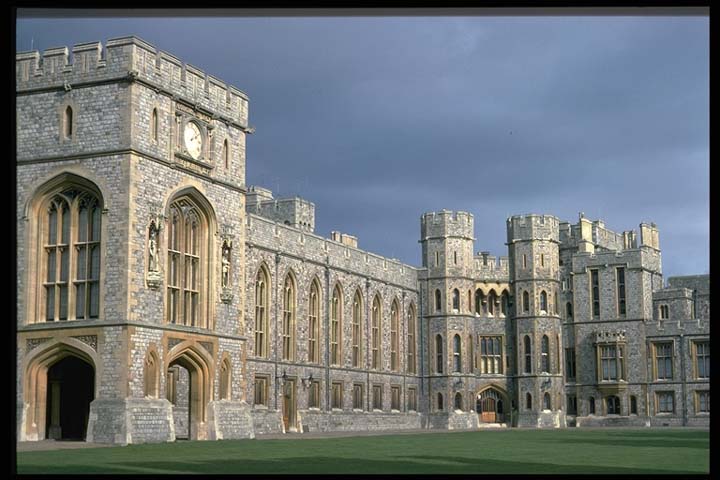- Windsor Castle
-
n.residence of English sovereigns since the time of William the Conqueror, located in Windsor
* * *
a castle in Windsor (I)(1). It is one of the official homes of the British king or queen. It was started by William I in the 11th century, and parts were added to it by several later kings and queens. Most of the present castle was either built or decorated in the early 19th century. Some of the rooms are open to the public when the king or queen is not staying there. In 1992 some parts of the castle were badly damaged by a fire, but these have now been repaired.
* * *
Principal British royal residence, on the River Thames in Windsor, Berkshire, southern England.It comprises two quadrilateral building courts, or upper and lower wards, separated by the Round Tower (erected by Henry II), a massive structure built on a mound and visible for many miles. The present-day complex has been reworked repeatedly since William the Conqueror first constructed a stockade on the site. The lower ward includes the Albert Memorial Chapel and St. George's Chapel, the burial place of 10 sovereigns. The upper ward, part of which was damaged by fire in 1992, includes the monarch's private apartments, visitors' apartments, and the royal library.* * *
English royal residence that stands on a ridge at the northeastern edge of the district of Windsor and Maidenhead in the county of Berkshire, England. The castle occupies 13 acres (5 hectares) of ground above the south bank of the River Thames. Windsor Castle comprises two quadrilateral-shaped building complexes, or courts, that are separated by the Round Tower. The latter is a massive circular tower that is built on an artificial mound and is visible for many miles over the surrounding flatland. The court west of the Round Tower is called the lower ward; the court to the east is called the upper ward.There was a royal residence at Windsor in Saxon times (c. 9th century). William I the Conqueror developed the present site, constructing a mound with a stockade about 1070. Henry II replaced this with the stone Round Tower and added outer walls to the north, east, and south. In the 13th century Henry III completed the south wall and the western end of the lower ward and built a royal chapel on the site of the present-day Albert Memorial Chapel. Edward III made this chapel the centre of the newly formed Order of the Garter in 1348 and converted the fortress buildings in the upper ward to residential apartments for the monarchs. These apartments were rebuilt by Charles II and later reconstructed by George IV for use by visitors of state in addition to the monarchs.The lower ward includes St. George's Chapel and the Albert Memorial Chapel. St. George's Chapel (Saint George's Chapel), designed to be the chapel of the Order of the Garter, was begun by Edward IV and is one of the best examples of Perpendicular Gothic-style architecture. It was completed in 1528 and restored between 1921 and 1930. It ranks next to Westminster Abbey as a royal mausoleum and contains the bodies of Henry VI, Edward IV, Henry VIII and Jane Seymour, Charles I, Edward VII, and George V. The chapel also contains the impressive insignia of the Knights of the Garter. Albert Memorial Chapel, built by Henry VII as a royal mausoleum, was restored by Queen Victoria and named in memory of her consort. In this chapel are buried George III, George IV, and William IV.The upper ward of the castle includes the private apartments of the monarch and private apartments for visitors. The state apartments in the upper ward include the Waterloo Chamber, St. George's Hall, and the grand reception room. The upper ward is also the site of the royal library, which contains a priceless collection of drawings by Leonardo da Vinci, Michelangelo, Raphael, Hans Holbein the Younger, and other Old Masters. Fire destroyed the northeast corner of the upper ward in November 1992. Most of the paintings, furniture, and other movable treasures were saved, but more than 100 rooms, including St. George's Hall, were destroyed or damaged. A successful restoration of the affected area was completed in 1997.Adjacent to the castle on the south, east, and north is Home Park, which consists of approximately 500 acres (200 hectares) of parkland. Frogmore, the site of the mausoleum of Queen Victoria and Prince Albert, lies within the park. South of the castle lies the Great Park, with about 1,800 acres (700 hectares). The Long Walk, a 3-mile (5-kilometre) avenue leading into the Great Park, was planted by Charles II in 1685; its aging elm trees were replaced by younger trees in 1945. Virginia Water, an artificial lake, lies at the southern boundary.* * *
Universalium. 2010.
